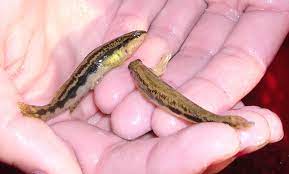In the 1970s, the tiny, endangered Tennessee fish, the snail darter, was in the news regularly — the subject of a Supreme Court ruling, an act of Congress, and a giant proposed dam that threatened it with extinction.
With Endangered Species Act protections over the last 40 years, conservation partners went to work protecting and restoring snail darters, conducting surveys that located additional populations, and reintroducing the fish to rivers it once called home.
“Due to these and other efforts and collaborations, our scientific status review has found the snail darter no longer faces the threat of extinction, and we are proposing it for delisting,” said the U.S. Fish and Wildlife Service this week.
“The Endangered Species Act was passed to ensure all wildlife, even species that some might view as insignificant, deserve to be preserved for future generations,” said Martha Williams, Service Principal Deputy Director. “It is very fitting that this fish, which was once a source of controversy, became the subject of cooperation and partnerships to save it. We would like to thank the many partners, including the Tennessee Valley Authority, which made this possible.”
The improvement to the status of the species is due to partnership work among federal and state agencies and the Reservoir Release Improvement Program managed by the Tennessee Valley Authority, which benefits darters and other species, said USFWS.
Snail darters grow to 2 ½ to 3 ½ inches long and eat insects, but mostly snails – hence their name.
The species first made news in 1975 when the Service listed it as endangered due to the threat posed by a proposed impoundment for the TVA’s Tellico Dam, near Lenoir City, Tenn. At that time, it was the only known location for the fish. Conservationists sued to stop the dam from being completed due to its threat to the fish. The snail darter was the first ESA case to reach the Supreme Court, and in 1978 the court ruled in favor of protections for the fish.
Following the Supreme Court finding, Congress passed an amendment exempting the Tellico Dam from ESA consultations on behalf of the fish so that it could be completed. President Jimmy Carter signed the bill into law in 1979.
Meanwhile, snail darters were collected from the Little Tennessee River and transplanted to the Hiwassee and Holston rivers in Tennessee and then to other locations within its native range.
TVA launched a Reservoir Release Improvement Program that increased dissolved oxygen concentrations in more than 300 miles of river downstream of TVA dams and improved water flows. In addition, TVA implemented several other techniques for increasing dissolved oxygen in its reservoirs, including turbine venting, compressors and weir dams. These programs increased water quality, allowing snail darters to recolonize the Tennessee River, benefitting not just the fish but countless other wildlife that also rely on clean, abundant water resources. Concurrently, environmental reviews conducted by TVA also helped minimize impacts to the species and its habitats.
In 2015, TVA biologists collected snail darters in new locations more than 100 river miles downstream of previously known occurrences. This initiated a focused sampling effort that extended throughout the entire length of the Tennessee River. TVA biologists have since documented snail darters in portions of eight of the nine Tennessee River reservoirs, a reach spanning 442 river miles.
“Environmental stewardship is an important part of TVA’s mission,” said Allen Clare, TVA vice president of River & Resources Stewardship. “We are committed to helping create healthy, oxygen-rich waters in which fish and other aquatic life can thrive, particularly in those areas below TVA’s dams. As part of our mission, we’ve contributed millions of dollars over the years to protect and improve water quality and habitat in the Valley, and these efforts were a key factor in improving the destiny of the snail darter.”
We are proud of the work we’re doing, and proud to support the U.S. Fish & Wildlife Service in their effort to protect and recover this species.”
The snail darter was downlisted from endangered to threatened in 1984 due to successful relocations and the discovery of new populations. It can now be found in Alabama, Georgia, Mississippi and Tennessee.
State water quality and wildlife laws will continue to protect the snail darter and its habitat if the species is delisted. In addition, its range overlaps with other federally protected aquatic animals, so its habitat will not be affected.
If finalized, the snail darter will join 52 species that have been removed from the ESA due to recovery since 1973, when the law was passed by Congress with bipartisan support. Another 56 species have been downlisted from endangered to threatened due to successful conservation efforts during this time. The Service’s current workplan includes planned actions that encompass an additional 60 species for potential downlisting or delisting due to successful recovery efforts.

